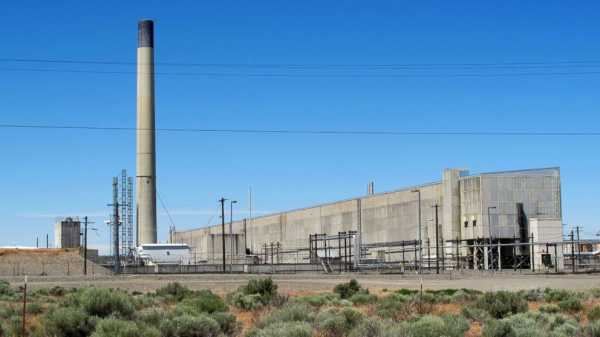
Seven decades after the adoption of the key parts of the atomic bomb dropped on Nagasaki, Japan, workers at the nuclear reservation Hanford exposed to radiation as they destroy buildings that helped to create the nuclear Arsenal of the country.
Dozens of workers of the demolition of the plant for processing plutonium from 1940-ies to inhaled or ingested radioactive particles in the last year, and even a little radiation on their funds, according to the U.S. Department of energy.
These incidents prompted the Federal government, along with state regulators to stop the demolition of spreading and finishing production of plutonium until a safe plan can be developed.
Pollution has also undermined the credibility of the massive cleanup of Hanford, the nation’s most polluted nuclear weapons production site. The work costs the Federal Treasury about $ 2 billion a year. Hanford is near the city of Richland, about 200 miles (320 km) South-East of Seattle.
“This is a very disturbing set of incidents,” said Tom Carpenter, head of Seattle-human rights organization Hanford challenge.
The Ministry of energy, which owns Hanford, has started an independent investigation into the spread of radiation at the plant. The investigation will be conducted in the Agency’s office that is not connected to work in Hanford.
Radioactive particles are known to contaminate 42 workers, which led to the shutdown of the demolition, the Agency said.
Carpenter said that the widespread contamination of the worker was rare at Hanford in the last decade. Plutonium production ended in the 1980-ies and on the site in 1989 he turned his attention to cleaning up nuclear waste.
“This is one of the more serious events occurred in the era of the cleanup in Hanford,” said Carpenter. “There were other incidents, but none rose to the level of contamination with plutonium, many people own personal vehicles, and being far away.”
The Union representing some Hanford workers, said he is closely monitoring the situation.
“We have our eyes on (Ministry of energy) and will do what we need to do to ensure the safety of workers,” said Paul Ruggles, Vice-President Hanford atomic metal trades Council.
Employees have the opportunity to immediately close the project, and feel free to do so if their security is threatened, said Ruggles.
Officials in Hanford issued a report in late March, said that a total of 42 workers Hanford inhaled or ingested radioactive particles from demolition and finishing production of plutonium when they had been subjected during the events of contamination in June and December last year.
The contamination also was found outside the offices of the plant and inside the two dozen cars, the report said.
House seven employees were tested for radioactive contamination, with nothing found, the message reads.
In the report it was concluded that Hanford officials rely too heavily on the system of monitoring of atmospheric air, that failed to pick up radioactive particles.
Managers of a private contractor that produces demolition work for the Federal government was also caught between maintaining security and trying to make progress on the project deadlines, according to the report.
The risk of escalation as the walls of the plutonium plant was destroyed, and rubble was stored in piles. Fixatives are sprayed on the gravel to keep radioactive particles blows may not have been effective, the report said.
In addition, the state Department of health found very small amounts of radioactive contamination of air and highway 240 In the past year, which could occur due to the demolition of the plant 10 miles (16 kilometers).
The amount of radiation was low, even lower than natural level of radiation a person is exposed to in everyday life. But the project was not to subject workers to any additional radiation. The amount of radiation that escaped are considered too small by state experts to present a risk to health. All the contamination was discovered on land that are closed to the public.
Hanford was created during the Manhattan project during World War II and produced the plutonium for the atomic bomb dropped on Nagasaki, Japan, which effectively ended the war. In finishing the Production of plutonium was constructed a few years later, and helped to handle most of the plutonium for the nuclear Arsenal of the country. The plant was liquid plutonium and turned it into a hockey puck-Size discs for use in nuclear warheads.
Demolition of the plant began in the end of 2016.
Carpenter complained that the Ministry of energy to act quickly to curb pollution after the incident, during which radioactive particles escaped and traces were found inside the 31 workers. Eleven workers were infected after the December incident, which forced the government to close down.
Carpenter is expected to be more radiation to emit in the environment.
“Hanford is a very polluted place, which has a lot of old objects become older,” said Carpenter. “This is a bad combination.”
The Washington Department of ecology, which, along with the United States Agency for environmental protection regulates Hanford cleanup, said the two departments will not allow demolition work to resume at the factory.
“We do not believe that energy has sufficient safeguards or controls to ensure safe operation,” the Department of ecology said in a press release. “This is clearly unacceptable for the worker and public health and safety.”
The state health Department reported that at present no threat to public health from emissions.
“We are concerned, however, if the work resumed without gain control, the risk to the public, can develop,” the Agency said in its latest letter, the Hanford managers.
Sourse: abcnews.go.com






